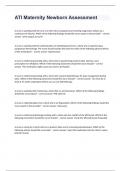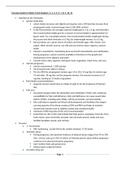Lecture 1
Why bother to learn how to learn how to search the literature for interventions with evidence?
desire for truth
increase ability to deliver best treatment (within one’s expertise)
referral decisions
what to invest re: career development
what to avoid
o critical incidence stress debriefing (increase PTSD sx’s)
o grief counselling for normal bereavement (increase depression)
Francis Bacon was an important thinker in het Scientific Revolution.
“If we are to achieve results never before accomplished, we must employ methods never
before attempted”.
Idea of science as “the reliable product of disinterested and dispassionate inquiry” that “went hand
in hand with the idea that such knowledge could be a tool for improving the human lot” (Gottleib,
1996).
Evidence based medicine: integrating individual clinical expertise with the best available external
clinical evidence from systematic research.
Mesmer: with magnets, magnetic field of the body, would open up the fields, and the person would
get better.
The 1784 Commission on Mesmerism:
a number of experiments, such as mesmerizing groups of differing social class
conclusion part 1: it works for some people
Learning objectives for this lecture:
learning how to search for scientific evidence
learning how to formulate a clinical question
learning how to appraise the quality of scientific evidence and methods for improving quality
knowing about possible biases in published evidence
,Searching for scientific evidence:
scientific journals:
o quality (reputation: impact factor)
o research perspective
fundamental
applied
specific EBMH journals and websites
o Evidence Based Mental Health
scientific data bases
o university library
o cochrane library (systematic reviews and meta-analyses)
Search within databases: PICO framework
systematic search protocol
to formulate a well-focused clinical question
to retrieve a higher % of relevant citations (in Pubmed, Medline, PsychInfo)
PICO(TT) framework (developed for therapy questions)
Patient/Population – who or what?
Intervention – could include diagnostic test, treatment, prognostic factor
Comparison – what is the main alternative? (If appropriate)
Outcome – what are you trying to accomplish, measure, improve, effect?
Type of question – therapy, diagnosis, etc.
Type of study – the design that is best for the question
review the literature and summarise
For example, is melatonin (I) helpful for children with ADHD and insomnia (P) to help concentration
at school (O), relative to a placebo (C)?
The default is that we initially believe everything that we see or hear. We need to have motivation
and opportunity to disprove the evidence.
Operationalisation
effect size: moderate = a few patients with large changes? many patients with smaller
changes?
percent improved: of completers or all who entered?
Types of control:
no treatment
wait-list
treatment as usual (TAU) ( = very often substandard care)
, active control
No treatment, wait-list, TAU:
control for passage of time
do NOT control for common factors (therapeutic alliance)
do NOT control for expectation/ placebo
EBM is the integration of best research evidence with clinical expertise and patient values.
What constitutes “best”, or “good enough” in regards to control group? Mesmerism worked
(likely would have significant results even when using no-treatment control). Although mesmerism
works for some people, it is due to suggestion.
RCT methods
unlike pharmacological RCTs, double-blinding is difficult
o depressed patient enrolled in a study is likely to know whether he is receiving the
real treatment
active control: expectancy very (!) rarely assessed
o intervention provider is likely to know whether he is providing the real treatment
“Failure to control for the confounding effect of differential expectations is not a minor omission – it
is a fundamental design flaw that potentially undermines any causal inference”
Quality of control group influences outcome
little research has compared expectancies between intervention and control
Baskin et al. (2003) compared control that was or was not structurally matched to
intervention
o e.g. # sessions, length
of sessions, format
(group v. individual),
therapist training
effect size was reduced by 68%
overall when conditions were
structurally equivalent (!!!)
In this graph, the more quality a study
had, the lower the effect size was.
Confirmation bias
tendency to favour information that confirms our theory (beliefs, hypotheses)
“the human understanding when it has once adopted an opinion (either as being the
received opinion or as being agreeable to itself) draws all things else to support and agree
with it” ~ Francis Bacon
EST criteria for well-established: at least two good between-group design experiments must
demonstrate efficacy equivalence to already established treatment with adequate sample sizes











